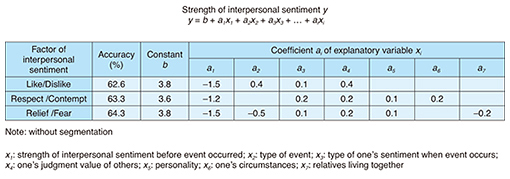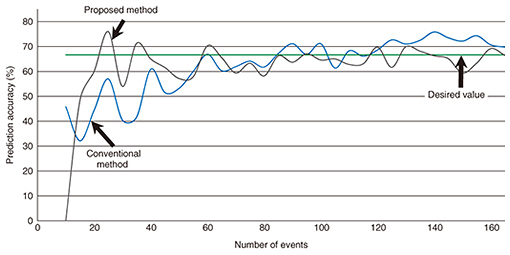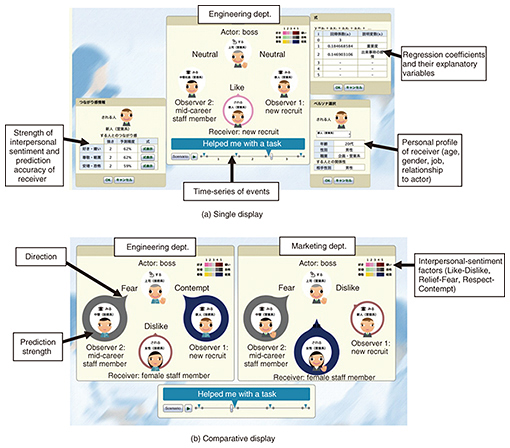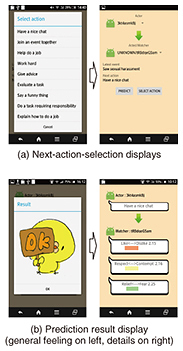 |
|||||||||||||||||||||||||||||||||||
|
|
|||||||||||||||||||||||||||||||||||
|
Regular Articles Vol. 15, No. 3, pp. 33–47, Mar. 2017. https://doi.org/10.53829/ntr201703ra1 An Interpersonal Sentiment Quantification Method Applied to Work Relationship PredictionAbstractFor a business to be successful, it is important for people in the business to consider how other people feel, that is, to consider interpersonal sentiment. Our research goal is to quantitatively predict the strength of interpersonal sentiment by analyzing a small amount of data on office employees, for example, their gender or age group, and data on events such as giving positive feedback on work done and sexual or power harassment without directly asking someone about their change in sentiment. In this article, we propose an interpersonal-sentiment-changing model for this quantification and propose two new analysis methods for developing prediction formulas. These methods can be used even if 90% of data is missing and in environments in which it is difficult to gather data in a comparatively short time. We also implement two visualization systems to predict how interpersonal sentiment changes for each event based on actual office data. Keywords: interpersonal-sentiment prediction, sparse regression, factor regression, visualization, missing data, personal relationships in offices 1. IntroductionFor a business to be successful, it is important for the people involved to consider a mental model for work relationships. Let us consider one office scenario (Fig. 1). There are two people, a boss (Boss) and a subordinate (Mike). The relationship between the two is normally positive. One day, Boss yelled at Mike in front of everyone. Boss believed that being strict is important for guiding subordinates and gains a sense of superiority by acting in this manner toward Mike. However, Mike feels he is being harassed and feels contempt toward Boss. Thus, Boss and Mike have opposite interpersonal sentiments, and this affects the other people in the office. These unmatched emotions can negatively affect relationships if nothing is done. Therefore, it is important to make Boss aware that Mike feels contempt toward him in these instances. In other words, Mike’s interpersonal sentiment for Boss can be predicted, and a function is needed that conveys Mike’s sentiments to Boss.
In this article, we describe a way to predict the strength of interpersonal sentiment quantitatively. We statistically predict the strength of interpersonal sentiment by using as little data as possible about office employees, for example, just their gender or age group, without directly asking them whether or not their sentiment has changed. We describe related work and our motivation for this research in section 2. In section 3, we define the interpersonal sentiment discussed in this article. We give an overview of our approach in section 4. In section 5, we explain the proposed interpersonal-sentiment-changing model, and in section 6, we describe how to select investigation items in actual environments through statistical analysis using large-scale data. In section 7, we derive prediction formulas using data from target offices. We evaluate and discuss the estimation accuracy of interpersonal sentiment using these analysis methods. We explain two types of visualization systems for office managers and for office employees in section 8. Finally, we give concluding remarks in section 9. 2. Related work and motivation for this researchIn order for businesses that focus on human relationships to succeed, the businesses cannot ignore mental information such as whether people like or dislike something. They also must focus their efforts on a wide range of people (e.g., office employees, students, and teachers) and develop practical interpersonal-sentiment-estimation tools. Interpersonal sentiment has been investigated from two viewpoints, psychological and engineering, and extensive research has been done on the effects of interpersonal sentiment on behavior in personal relationships, for example, parent-child interactions, conflict, negotiation, and leadership. A framework that can account for current findings and guide future research, called the emotions-as-social-information model, has been proposed [1, 2]. Many psychology studies have been conducted from micro- and internal viewpoints and have involved fragmentary trend analysis limited to female students or senior citizens. There has also been extensive engineering research involving data analysis for automatically recording human behavior using sensors or radio frequency identifiers and web social data [3–5]. Emotion estimation has been investigated using voice and image data analyses [6–8]. Such research goals can be achieved through engineering technology with which people can superficially judge their own emotions by sight. That is, if a person smiles but is inwardly angry, engineering analysis is adequate in only detecting the smile. Thus, many engineering studies have been carried out from macro- and superficial viewpoints. However, the aspect of psychology has not been used in the engineering field. As mentioned above, we aim to be able to use mental information in applications targeted for humans. However, many psychology studies involved have focused on trend analysis rather than quantification, so psychology research results are difficult to use in applications involving the controlling of human relationships in the workplace. There is currently a wide gap between psychology research and engineering research. We have combined psychology with engineering using statistics, and we use these statistics for sentiment quantification. 3. Interpersonal sentimentIn this article, we describe interpersonal sentiment as the way another person/other people feel. Interpersonal sentiment changes depending on events, and the sentiment has two main aspects, negative and positive. In psychology, interpersonal sentiment consists of several factors [9–13]. We focus on three such factors: like-dislike, respect-contempt, and relief-fear because they greatly concern office managers with regard to their subordinates. 4. Approach for predicting strength of interpersonal sentimentWe applied a four-step approach (explained below) and used the application candidates indicated in Fig. 2. With these candidates, we first clarify the interpersonal sentiment of one-to-one (1:1) relations in single and bi-directions. The application candidates are human relations in offices (target for this article), manager training, care support, and fortune-telling. The next phase involves clarification of interpersonal sentiment in one-to-many relationships (1:n), for example, teacher to students. The application candidates for this type of relationship are prevention of bullying, evaluation of personal magnetism, evaluation of meetings or lectures, and notifying people of breaches in public manners. In the final phase, the approach is expanded to many-to-many relationships (n:m), for example, department-to-department relations. The application candidates are evaluations between company structures or different companies, and remote-meeting support. In this study, we targeted the 1:1 relation of the first phase.
It has not been previously clarified which data are needed to predict the strength of interpersonal sentiment in actual work relationships. We used a statistical method in a top-down approach to identify what types of data are needed for the sentiment prediction. In this approach, we list every conceivable type of data and select from those that are useful (variables) using regression analysis. We follow the following four steps. Steps (1) to (3) are repeated several times to increase the prediction accuracy. (1) Design of interpersonal-sentiment-changing model (2) Selection of investigation items in actual offices through statistical analysis using large-scale data (3) Derivation of prediction formula using actual target office data (4) Visualization on personal computers (PCs) and smartphones These steps are described in more detail in the following sections. 5. Design of interpersonal-sentiment-changing modelWe developed a model reflecting how our interpersonal sentiments are constructed. A conceptual diagram for changing interpersonal sentiment depending on the event is shown in Fig. 3. The x-axis is the flow of time, and the y-axis is the strength of interpersonal sentiment y. In Fig. 3, we use the interpersonal sentiment factor of respect-contempt as an example. The strength of the sentiment is on a 5-point scale, where 1 represents great respect and 5 represents great contempt, with 3 being neutral.
Let us consider the scenario using Fig. 1. Two people, Boss and Mike, a subordinate, are in an office. They initially respect each other. When event A occurs in which Boss yells at Mike in front of everyone, Mike feels bad due to Boss’ action (stage 1). The strength of interpersonal sentiment regarding respect-contempt before this event y(tA) decreases from 2 (respect) to 4 (contempt) after the event y(tA+Δt). However, with time, we usually cool down and return from contempt to a more positive sentiment, 3 (neutral), before the next event (event B) y(tB) (stage 2). In other words, Mike’s sentiment toward Boss becomes stable over time. After a certain period, event B occurs with similar results to event A. Thus, we argue that stable interpersonal-sentiment results by repeating the combination of stages 1 and 2 several times. Thus, we consider the basic model as consisting of two stages depending on the event. The prediction goals are as follows. (1) Small number of variables needed for prediction We use a regression formula for the interpersonal-sentiment prediction. The regression formula developed using general regression analysis has many variables. Therefore, when we calculate the prediction using the regression formula, we need to prepare the data for these variables. When considering the load for the formula user, we have to reduce the number of variables. Our goal is to have fewer than ten variables. (2) Estimation accuracy The estimation accuracy of interpersonal-sentiment strength should be approximately 60–70% with a +/– 0.5 margin of error when using a 5-point Likert scale to rate the three factors mentioned in section 3. We preliminarily interviewed office managers regarding prediction accuracy, and they said that achieving a level of accuracy of approximately 80% was not necessary at first because there has been no quantification of interpersonal sentiment in office environments. They wanted to detect signs of deteriorating situations in the workplace, even if they might be wrong. Therefore, prediction accuracy should be set to higher than 60% on a 5-point Likert scale, although the accuracy rate is 20% stochastically. 6. Selection of investigation items in actual offices through statistical analysis using large-scale dataIn this section, we explain the process used to gather and analyze data. 6.1 Acquisition of large-scale dataWe gathered calculation data based on our interpersonal-sentiment-changing model illustrated in Fig. 3. We gathered 130 potential explanatory variables for predicting interpersonal sentiment that were referred to in previous psychology and engineering research. (1) Static variables of responses about oneself
(2) Static variables of responses about others in the office The others’ statuses in the office, gender, age (older or younger), distance of desk from others (whether two people sit near each other), things in common (e.g., school, hometown, and experiences), how they spend private time, communication tools often used with others (e.g., LINE (social networking app), voice, or email) and duration (e.g., 10 minutes or 1 hour), and how much private information is shared via work email (e.g., if the other is on familiar terms, messages may contain private information such as an invitation to dinner or news about the family.). (3) Interpersonal sentiment-related variables
A large amount of data is needed for statistical analysis. We used a web questionnaire as an efficient data-gathering tool for the short term. The web questionnaire was conducted in January 2012. We obtained about 9000 responses. 6.2 Features of web questionnaire data and problem from viewpoint of statistical analysis(1) Features Sentiment is subjective; therefore, we have to prepare various choices in order to obtain the truest possible responses. In the first-impression investigation mentioned in section 6.1, we prepared a multiple-choice question asking respondents to choose 10 out of 94 items on what is important regarding first impressions. Each person reacts differently to words, so even if the same impression term was shown, for example, on the appearance of a good-looking man, we provided several words such as cool, cute, good, and smart. In our questionnaires, the respondents all chose the first 6 question items, and the other 4 were random throughout the remaining 88 items. (2) Problem As a result, 84 items were not chosen, resulting in a huge amount of missing data, about 90% (shaded region in Fig. 4). Therefore, the method of conventional statistical analysis makes analysis difficult.
6.3 Sparse factor regression analysis with large amount of missing dataWe used a missing-data algorithm to estimate several of the regression-formula parameters. Regarding our data problem described in section 6.2, we have to determine why the data are missing. Rubin classified the following three types of missing-data mechanisms [15]. The analysis method differs depending on which mechanism is assumed. These mechanisms describe the relationships between measured variables and the probability of missing data. (1) Missing completely at random (MCAR) The MCAR mechanism means that data are missing independently of both observed and unobserved data. (2) Missing at random (MAR) The MAR mechanism means that when the observed data are given, data are missing independently of unobserved data. (3) Missing Not at Random (MNAR) The MNAR mechanism means that missing observations are related to values of unobserved data. We assume that the missing data (unobserved data) are due to the variable not being chosen from the response. Therefore, we assume the MAR mechanism can be used. We conducted a factor analysis that can be used even if there is a large amount of missing data. Moreover, the factors not derived from factor analysis must be used in regression analysis. We want to minimize the number of useful explanatory variables for interpersonal-sentiment prediction discussed in section 5, even though we listed many candidate variables. Because variables (explanatory variables in regression analysis) may be used as input items in business, for example, in human-relation predictions in an office, having a large number of explanatory variables makes the prediction formula cumbersome and complicated. The variables chosen from sparse regression modeling are used as the explanatory variables of the interpersonal-sentiment-prediction formula. The number of variables is small, which leads to better privacy protection in service systems because such systems do not need to keep user data that are not necessary for sentiment prediction. As the number of variables decreases, the input load decreases when using the prediction formula. In this article, we focus on sparse factor regression analysis, and we describe the proposed analysis method based on a large amount of missing data as follows. Let the predictor and responses be xn and yn, respectively. In the factor regression model, prediction can be done directly by m latent factors fn as follows:
where Λ and Θ are factor loadings, and ξn and εn are error variables. The joint distribution (xn, yn) can be expressed as
The above equation can be regarded as a standard factor model:
where 6.4 Evaluation resultsWe proposed the regression formulas for calculating y(tA+Δt) in Fig. 3 using the method described in section 6.3 (Fig. 5). There are several regression analysis models for obtaining prediction formulas (regression formulas). We used a linear regression model because it is easier to interpret with derived explanatory variables than a non-linear model. Moreover, when we create a graph of discrete values for each variable, the graph shape is not a curve fitting a non-linear model.
The regression formulas and their measured accuracy of interpersonal sentiment are listed in Table 1.
The strength of interpersonal sentiment y based on the linear model shown on the y-axis in Fig. 3 is expressed as follows:
where b is a constant and ai is a coefficient of explanatory variable xi (input items of prediction formulas). Three factors of interpersonal sentiment are described in section 3. Our prediction goal was to have ten or fewer variables to reduce the formula user’s load, as explained in section 5. In selecting explanatory variables, we first ensure that the absolute value of ai is not close to zero since we are using sparse factor regression. Greater absolute values of ai are useful to estimate y for each factor of interpersonal sentiment. The prediction accuracies listed in Table 1 are the averages of 5-fold cross-validation. We evaluated the prediction accuracy with and without segmentation of all data. As a result, the prediction accuracy for all three factors was more than 60% without segmentation. We confirmed a prediction accuracy of approximately 70–80% when the data set was divided into several segments using explanatory variables of greater absolute values of ai, types of events x2, or initial strength of interpersonal sentiment before an event occurred x1. We also found that the approximately 60% accuracy was for all three factors involving only four to six variables (see Table 1, the number of ai variables). The useful variables were x1, the initial strength of interpersonal sentiment before an event occurred, x2, types of events, and x4, one’s judgment value of others. That is, only up to ten input items at most can be obtained from the prediction formula in which the prediction accuracy is higher than 60%. Conversely, about 120 input candidate items out of the 130 items described in section 6.1 were not useful for predicting interpersonal sentiment. 7. Derivation of prediction formula using actual target office dataHere, we describe how we derived prediction formulas using actual data. 7.1 Problems in gathering data in actual office environmentStatistical analysis is generally necessary for large amounts of data to derive prediction formulas. However, there are two problems with the field data of actual target offices, as shown in Fig. 6 and as follows.
(1) Problem 1 In an actual office, events in which interpersonal sentiments change do not occur frequently. Therefore, a long investigation period such as more than half a year is necessary to acquire an adequate amount of sample data for general statistical analysis. During a long investigation period, however, personnel changes occur regarding those who are gathering data to develop the prediction formulas. Moreover, office workers who are the subjects of such an investigation bear a heavy burden; thus, the quality of gathered data decreases. (2) Problem 2 We generally used Bayesian estimation for time-series and small-scale data. The derived prediction formulas using conventional Bayesian estimation consist of many variables. In conventional Bayesian estimation, Markov chain Monte Carlo (MCMC) methods can often be used. MCMC methods find an optimized answer from repeated computations. However, they have heavy computational loads. In contrast, when we want to minimize the number of variables of a prediction formula, we generally use sparse regression modeling. However, the conventional Bayesian estimation cannot use the standard lasso algorithm (sparse regression modeling). 7.2 Sparse Bayesian estimation methodIn this subsection, we describe the method of sparse Bayesian estimation. 7.2.1 Prior distribution of Bayesian estimation using the analysis results of large-scale dataThe proposed Bayesian estimation method is depicted in Fig. 7. To overcome problem 1, we use the analysis results of large-scale data through Bayesian estimation. As mentioned in section 7.1, conventional Bayesian estimation is useful to obtain an optimized answer from repeated computations such as with an MCMC method. To obtain an optimized answer with fewer repeated computations, it is important to set appropriate values to the prior distribution. To set the appropriate prior distribution, we propose using the analysis results of sparse factor regression analysis of a large-scale data set gathered from web questionnaires, as described in section 6.1. The data set involves the same kinds of jobs as in actual target offices. Bayesian estimation is generally used as a normal distribution for the prior distribution. Our proposed method uses the regression coefficient distribution obtained from sparse regression analysis for the prior distribution of Bayesian estimation developed using data set 1 in Fig. 7.
7.2.2 Sparse Bayesian estimation methodTo overcome problem 2, we use our method called the sparse Bayesian estimation method to carry out Bayesian estimation and sparse regression. We focus on the logarithm of posterior distribution on Bayesian estimation used in sequential learning from a few events, which becomes a quadratic function. Bayesian estimation is unified sparse regression that can refine the variables of a prediction formula. We estimate the posterior mode instead of the posterior mean. The estimation of the posterior mode corresponds to the penalized maximum likelihood estimation. The prior distribution is assumed to be a multivariate-normal distribution; therefore, the posterior distribution is also a multivariate-normal distribution, which implies the standard algorithm used in the lasso-type estimation, for example, the coordinate descent algorithm, can be directly used. The detailed algorithm is described below. The explanatory variables (e.g., gender and age) before an event are denoted as X, and the response variable (degree of connectiveness after the event) is denoted as Y. We conduct linear regression analysis to estimate Y from X, but the number of observations is often small. In this case, the estimator
Note that both likelihood function p(Y|θ, We consider the sparse estimation of θ via L1 regularization such as the lasso. Instead of using the negative log-likelihood −log p(Y|θ, 7.3 Diary methodWe gathered the actual target office data using the diary method that we designed based on the interpersonal-sentiment-changing model shown in Fig. 3. Office employees had to keep a daily diary that includes information such as other staff members’ names, events, and the changes in the strength of their interpersonal sentiments. Approximately 30 of the 130 candidate investigation items were selected through the sparse regression results described in section 6.4, including correction items for the target office. The 30 investigation items were as follows. (1) One-time investigation items
(2) Everyday investigation items
The prediction was y(tA+Δt) as shown in Fig. 3, and the correct answer values of y(tA+Δt) are the strength of the three factors after the event. The data obtained using the diary method to investigate human relations were gathered in four actual offices of an NTT Group company from Oct. 24 to Dec. 15, 2014. The data were input using an HTML (Hypertext Markup Language) interface. Since the interpersonal-sentiment data of office employees were very sensitive, the employees were allowed to answer the questionnaires in the privacy of their homes, as more accurate human-relation data could be gathered. The basic analysis results of gathering data were as follows. (1) Office staff (respondent) attributes
(2) Number of events that occurred over two months: 167
(3) Examples of main positive events
(4) Examples of main negative events
7.4 Evaluation results and discussionThe evaluation results are shown in Fig. 8. The x-axis is the number of events, and the y-axis is the prediction accuracy. We analyzed 167 events that occurred during the two-month investigation period. The factor of interpersonal sentiment was respect-contempt. Data set 1 consisted of about 3100 data samples. The straight green line is the prediction accuracy using sparse factor regression analysis discussed in section 6.3 by using all 167 events. The blue line is the prediction accuracy using the conventional Bayesian estimation method, and the grey line is the prediction accuracy using the proposed sparse Bayesian estimation method. The weight coefficient τ of the initial distribution with the proposed sparse Bayesian estimation method was 1.0. The initial distribution with the conventional Bayesian estimation method was assumed to be uniform (τ = 0).
We checked which of the two methods converged more quickly to the straight line of 67% (desired value) estimation accuracy. Calculations using both methods were started after ten events. The input items were sequentially input using both methods in the order the events occurred. The prediction accuracy of the two methods took an average of five times for two-fold cross-validation of the data of all 167 events. Both methods began to converge from about 85 events. However, the estimation with the proposed method was more stable than that with the conventional method. That is, the proposed method had less dispersion in estimation accuracy than the conventional method. Therefore, the convergent start point of both methods was almost the same; however, the proposed method became stable faster than the conventional method. There were four useful variables: the initial strength of interpersonal sentiment before an event occurred, types of events, types of occupation, and personality. Next, we estimated the accuracy enhancement regarding the respect-contempt factor. We focused on the regression coefficient of all data using our diary method. The explanatory variables of a large regression coefficient were gender (= 0.2) and event type (= 0.4). In this article, we have focused on event type, which were segmented into positive and negative events. There were 136 positive events and 31 negative events out of the total 167 events. There were too few negative events for our sparse Bayesian estimation method; therefore, we used the 136 positive events. After data cleansing, we analyzed 111 positive events. The prediction accuracy takes an average of five times for two-fold cross-validation of office data for the 111 positive events. The prediction accuracy was 77%—about 10% higher—by segmentation. Thus, we achieved our prediction goals of obtaining more than 60% prediction accuracy and having ten or fewer variables. The proposed method converged at about 60 events, and the conventional method converged at about 80 events. That is, the proposed method converged with about one-fourth fewer events than the conventional method. The diary method we used required 30 days to gather the data on 60 events. Thus, we obtained a prediction formula after at least 20 days of learning using the proposed method. This 20-day learning period is sufficient for practical use. 8. Visualization on PCs and smartphonesTo our knowledge, no studies have been done on the visualization of human personal relationships from a psychological point of view. We implemented two types of visualization systems. One is for office managers or human resources staff, and the other is for general office staff. 8.1 Visualization system for office managersWe attempted to visualize the change in the prediction of invisible interpersonal sentiment as a tool for managers. We implemented a visualization system as shown in Fig. 9. We prepared two types of visualization displays, a single (Fig. 9(a)) and a comparative visualization screen (Fig. 9(b)). We assumed an actual office scenario in which interpersonal sentiment changes and is easy to visualize in an actual office. In this visualization system, the privacy of responses and an interface for observers were not considered. We will investigate these issues as future work. The comparative visualization display (b) has the same functionality as display (a). The difference is that the interpersonal-sentiment variation in two different departments can be compared for the same events. For example, we can see the difference in interpersonal-sentiment variation between an engineering department and a marketing department.
The system requirements for visualization are as follows. Operating system (OS): Mac OS X 10.8.4, HTTP (Hypertext Transfer Protocol) server: Apache 2.2.22, runtime: JDK (Java Development Kit) 7.0_45, browser: Firefox 25, processor: 1.3-GHz dual core Intel Core i5, memory: 4-GB 1600-MHz LPDDR3, storage: 256 GB. 8.2 Visualization system for office staffIn this section, we describe the system to visualize how an office staff member is feeling. The visualization target is the sentiment of a person, so it is very sensitive. It is necessary to carefully investigate changing interpersonal sentiments, depending on who observes the human relations that are visualized. It may be necessary in some cases, for example, when the information made visible is viewed by individual office workers in the workplace, to add minor falsifications of the true predicted values tuned to improve human relations, or to refrain from showing direct information about the people involved in order to protect privacy. To prevent information displayed from being seen by others in the workplace, we implemented the system on smartphones; therefore, users can input data in a private space. The following components are involved in the visualization process. First, the gender, age, and position of the person we want to visualize in the organization have to be set. To simplify the relationship information, we decided to allow only the following two types of individuals to be set: (1) One who provoked an event (2) One who is affected by having witnessed the event The prediction of the sentiments between the two set individuals was executed by using the formula mentioned in section 7.2. The data collected from the diary method during in-context experiments were used. The visualization system was designed as an application for smartphones and implemented on a smartphone. The specifications of the smartphone were as follows. Smartphone: AQUOS SERIE mini SHV31, central processing unit (CPU): MSM9874AB 2.3-GHz Quad-core, memory: 2 GB, storage: 16 GB, OS: Android 4.4. In consideration of client-side processing constraints and the high privacy level of manipulated data and results, we implemented the proposed sparse Bayesian estimation method mentioned in section 7.2 using R language, and events or user information files were run or stored on an Apache server. The server specifications were as follows. CPU: Intel Core i5-2400 3.1-GHz Quad-core, memory: 8 GB, storage: 128 GB, OS: Windows 10 Pro 64 bit, HTTP: Apache 2.4.17. The displayed images are shown in Fig. 10. The display combined actual and predicted data; the predicted data were displayed after displaying the actual data collected as the training data set. Specifically, relationships should be expressed through a quiz-style interface such as “Here is the current relationship status; choose the next action and see how the relationship turns out” (Fig. 10(a)). A warning may be displayed when a prediction mismatch occurs (chosen action leads to relationship deterioration). The scenario illustrates the case of monitoring the relationship between colleagues or between full-time and temporary employees. Therefore, the application is suitable for both managerial and subordinate positions. For example, it is possible to input an event such as one that may lead to power harassment, whether you are the actor (the person who provoked the event), the receiver (the person who suffered from the event), or the observer (the person who observed the event). The interface to visualize the prediction of the relationship depending on an event can be a quiz-style interface such as the one mentioned above: “Here is the current relationship status; choose the next action and see how the relationship turns out.” The major functionalities are as follows.
We used simple sentiments to more easily understand the prediction results, that is, whether the selected next action would be a positive choice. We have conducted demonstrations of this system many times, and it was well received based on the opinions of attendees. 9. ConclusionThe utilization of mental data is important for a business to be successful. In this article, we explained an interpersonal-sentiment-changing model and proposed two analysis methods to quantitatively estimate changes in interpersonal sentiments in an office by using psychological research and statistical data. The first proposed method is a data analysis method that assumes the MAR mechanism, even if about 90% of data is missing. This method is also simultaneously used for sparse regression modeling and factor regression analysis. The second method was a sparse Bayesian estimation method for time-series and small-scale data. For appropriating prior distribution of the method, we used large-scale data that had similar attributes to actual workers in the target offices. The large-scale data were gathered using web questionnaires, and the small-scale data of actual target offices were gathered using a diary method. With these methods, we achieved a prediction accuracy of more than 60% without segmentation and ten or fewer variables. When we segmented a data set using a variable of a large regression coefficient, the prediction accuracy increased by about 10%. We finally implemented two types of visualization systems for office managers and for office staff members. Managers can monitor a subordinate’s human relations on a PC, and staff members can monitor relations on smartphones. We demonstrated the visualization systems using actual office data. The demonstrations were well received based on the comments of attendees. References
Trademark notesAndroid is a trademark of Google Inc.Apache is a trademark of the Apache Software Foundation. AQUOS is a registered trademark of Sharp Corporation. Intel Core is a trademark of Intel Corporation in the United States and/or other countries. Java is a registered trademark of Oracle and/or its affiliates. Mac and OS X are trademarks of Apple Inc., registered in the U.S. and other countries. Windows is a registered trademark of Microsoft Corporation in the United States and/or other countries. |
|||||||||||||||||||||||||||||||||||


















